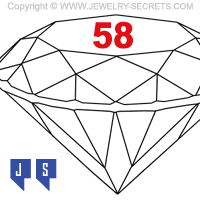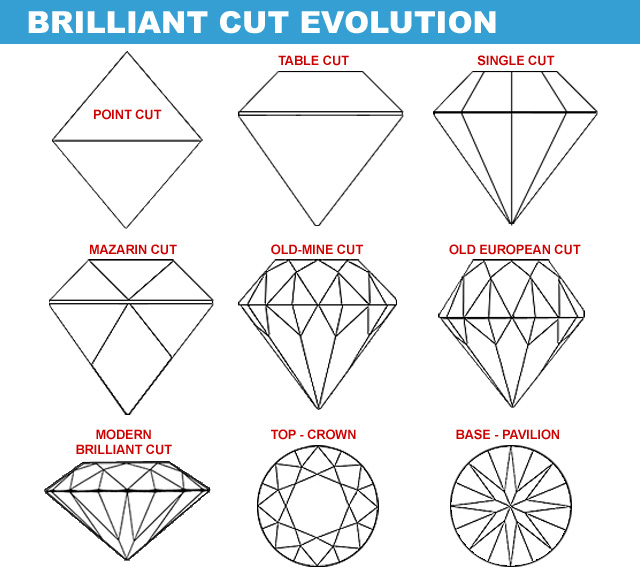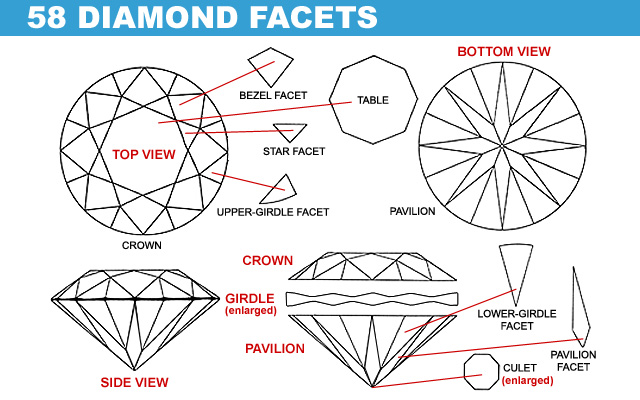WHY ARE THERE 58 FACETS ON A DIAMOND?
THE ART AND SCIENCE BEHIND 58 FACETS ON A DIAMOND
This post contains affiliate links. If you use these links to buy something I may earn a commission. Thanks! As an Amazon Associate I also earn from qualifying purchases.

Diamonds, renowned for their unmatched beauty and enduring appeal, owe much of their captivating sparkle to the intricate art of diamond cutting.
Among the crucial factors that contribute to a diamond’s brilliance is the number of facets it possesses.
Interestingly, diamond cutters have long settled on the magic number of 58 facets, a carefully calculated arrangement that maximizes the stone’s ability to reflect light and unleash its dazzling radiance.
So let’s delve into the history, science, and artistry behind the decision to incorporate 58 facets into diamond cutting.
The evolution of diamond cutting:
The journey of diamond cutting dates back centuries, with its earliest origins traced to the 14th century. Initially, diamonds were shaped into rudimentary forms, focusing primarily on retaining the rough stone’s natural shape and size. However, as the understanding of light behavior and the desire for enhanced brilliance grew, diamond cutting techniques began to evolve.

In the mid-17th century, the advent of the brilliant cut revolutionized diamond cutting. This innovative cut involved the placement of triangular and kite-shaped facets on the crown (top) and pavilion (bottom) of the diamond. This arrangement allowed for the dispersion and refraction of light, generating a breathtaking display of brilliance and fire.
The magic of 58 facets:
The decision to incorporate 58 facets into diamond cutting stems from a meticulous balance between maximizing light reflection and minimizing light leakage. Achieving this equilibrium requires careful consideration of various factors, including the stone’s refractive index, critical angle, and total internal reflection.
The 58-facet arrangement typically includes 33 facets on the crown and 25 facets on the pavilion. The crown facets are responsible for capturing and refracting light into the stone, while the pavilion facets reflect the light back out, intensifying the diamond’s brilliance.

Specific facets and their roles:
- Table Facet: Located on the crown, the table facet is the largest and most prominent facet. It acts as a window, allowing light to enter the diamond and travel through its internal structure.
- Crown Facets: These triangular and kite-shaped facets on the crown are strategically positioned to reflect and refract light, enhancing the diamond’s sparkle.
- Pavilion Facets: The pavilion facets, located on the bottom of the diamond, are designed to reflect light back through the crown, amplifying the diamond’s brilliance.
- Culet: Situated at the bottom-center of the diamond, the culet prevents chipping and enhances light reflection.
The science of brilliance:
The brilliance of a diamond is determined by its ability to reflect and refract light, resulting in the desirable play of light and sparkle. When light enters a diamond, it refracts, or bends, due to the difference in its speed within the gemstone. This bending of light is responsible for the dispersion of colors and the creation of the diamond’s fire.
Diamonds achieve maximum brilliance when light entering the stone strikes the pavilion facets at specific angles, allowing for optimal reflection within the diamond. The precisely calculated angles, combined with the 58-facet arrangement, ensure that light is reflected back through the crown, captivating the viewer with its unmatched radiance.
The decision to incorporate 58 facets into diamond cutting is a result of both scientific principles and artistic intuition. It strikes a delicate balance between maximizing light reflection and minimizing light leakage, resulting in a diamond that exudes unparalleled brilliance.
The enduring popularity of this facet arrangement is a testament to its ability to transform rough stones into breathtaking gems that capture the imagination and hearts of those who behold them.
See the full diamond’s beauty, by viewing diamonds close-up, and under magnification, like you can at James Allen here.
Cheers! :)














Leave a comment